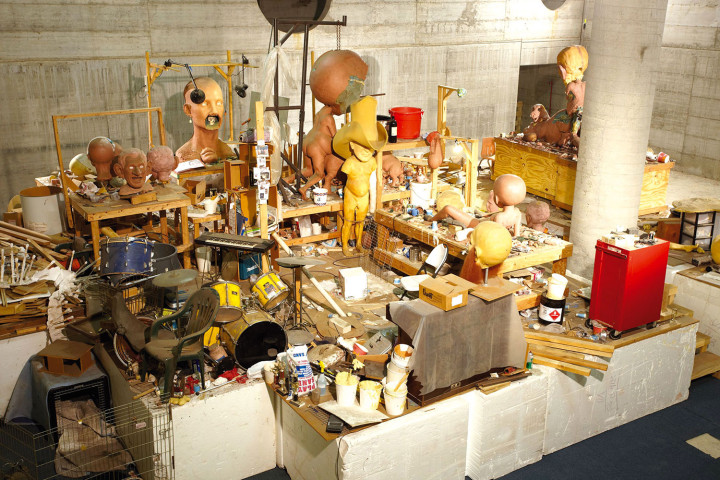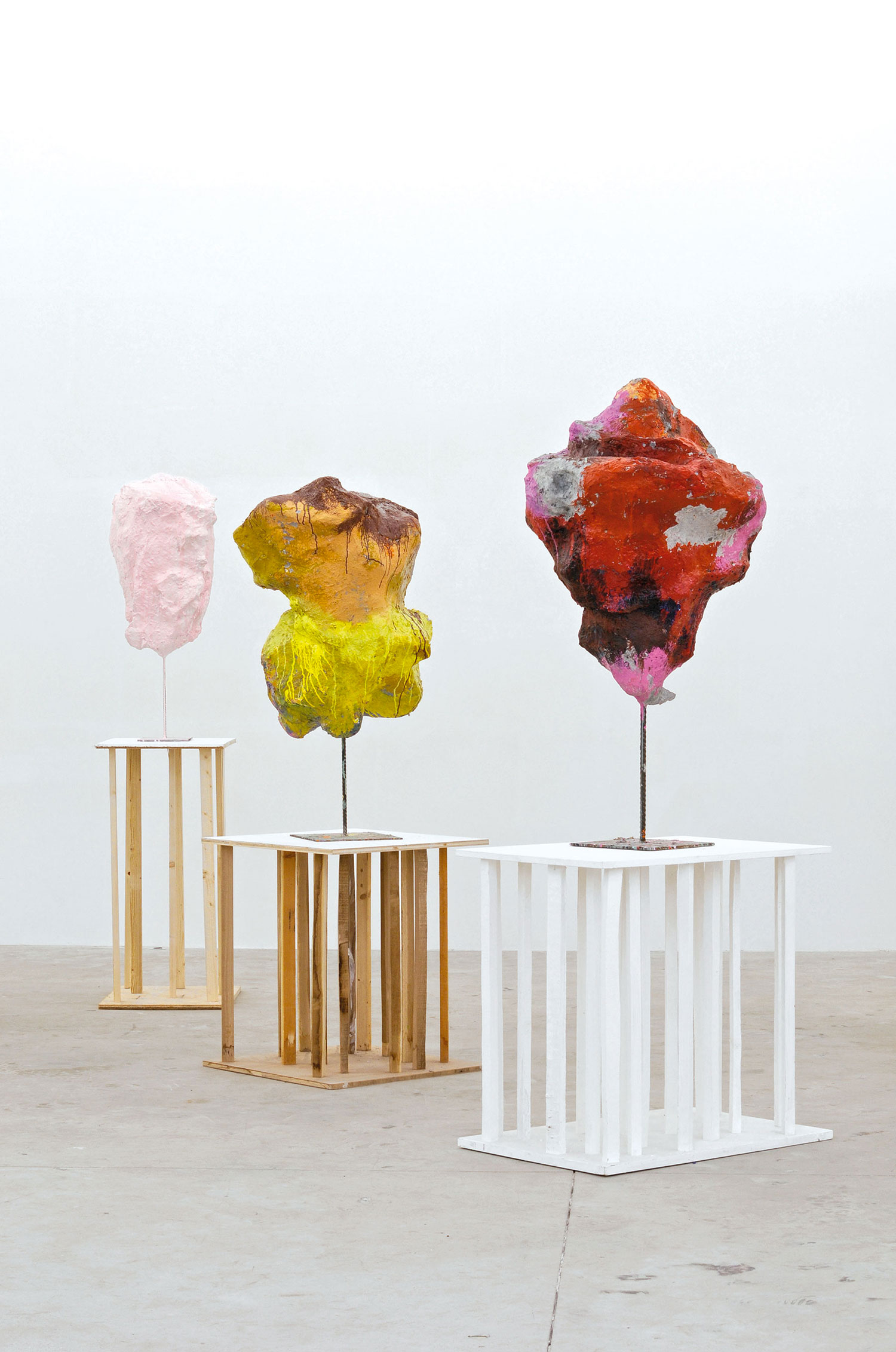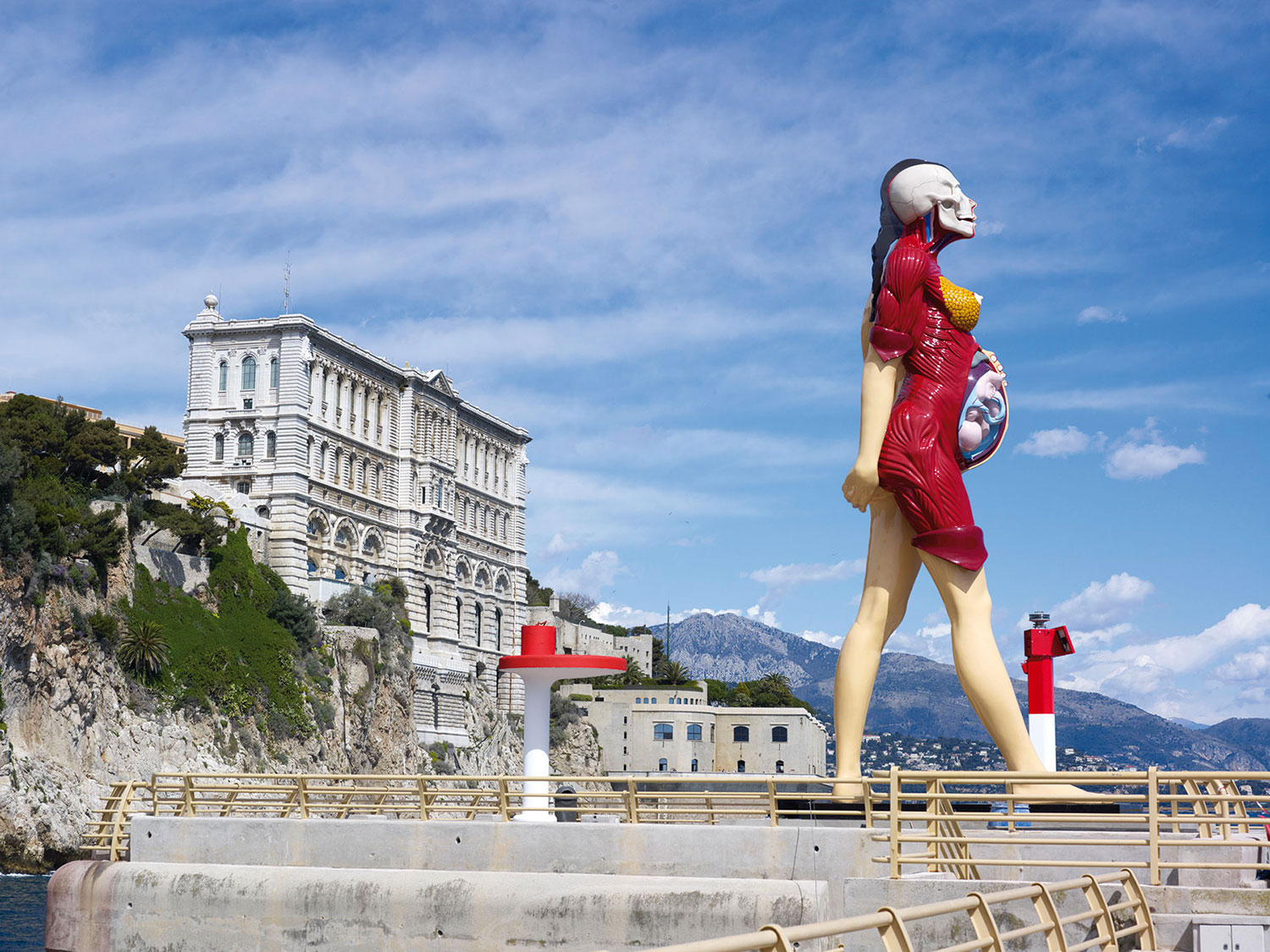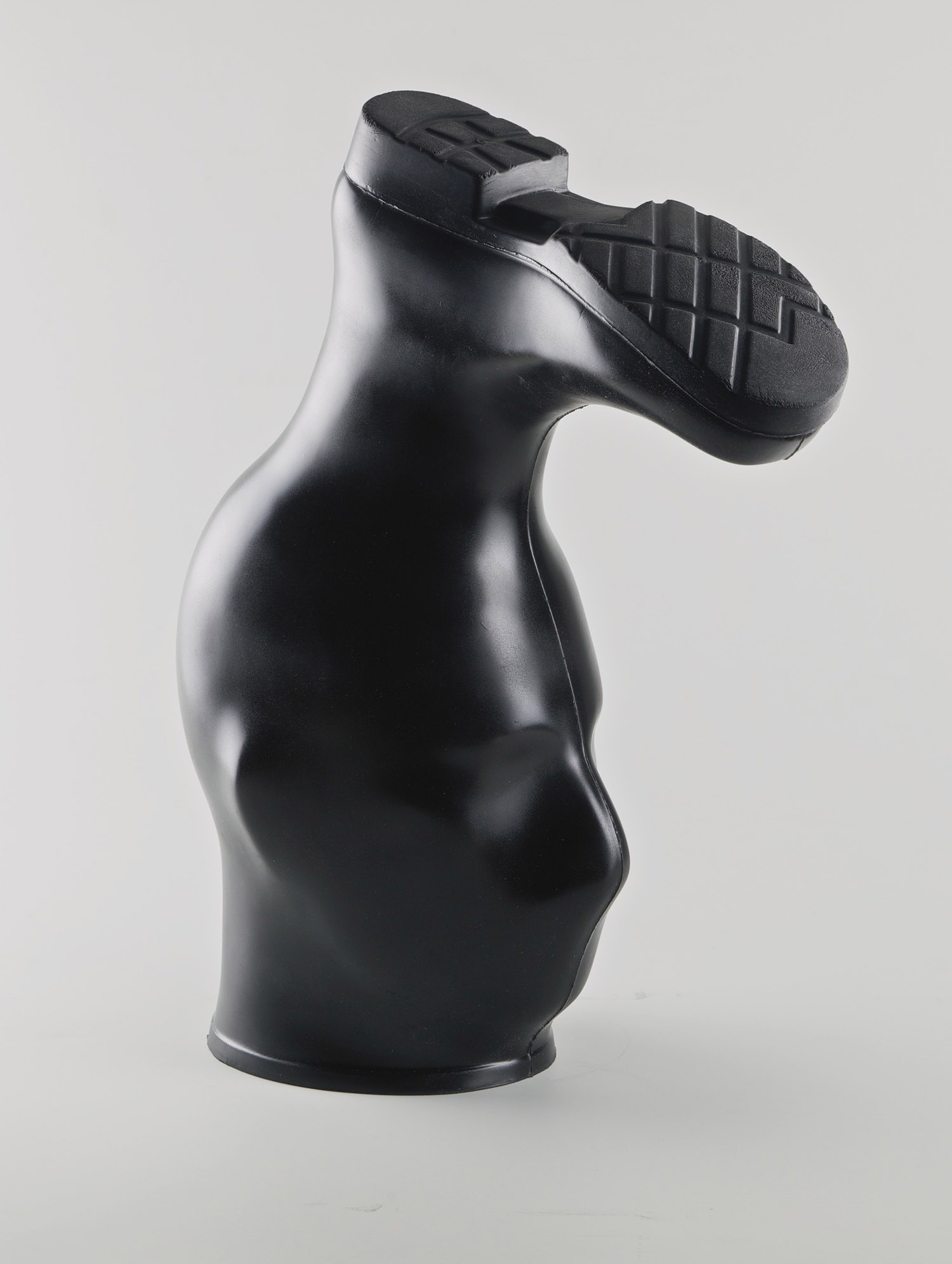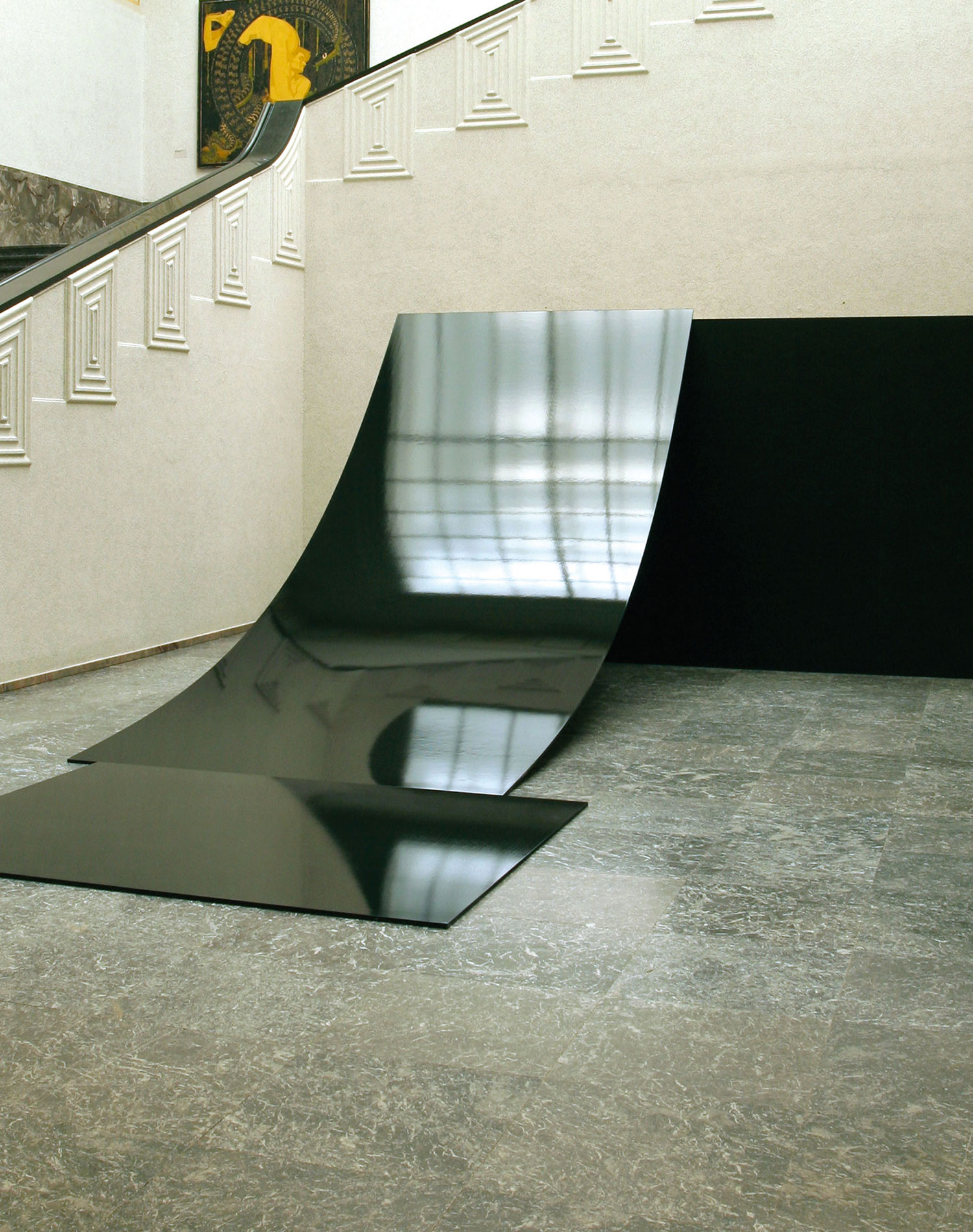
I recently came across this manuscript, hidden away in a safe that was unearthed from a Los Angeles dump. All evidence points to the theory that it is a set of notes from the ship’s log kept by Captain McCarthy during his crossing of the Great Gunky Sea. The manuscript measures 16 x 24 centimeters and is 64 pages long, written front and back on pieces of paper whose weight and texture call to mind old fast-food napkins. Here and there, its surface is stained with traces of ketchup.
Here are some selected excerpts:
Pig Island stands out in silhouette against a sea of carpet: floating on 26 blocks of polystyrene, like an iceberg in a cheap amusement park. The island is 11 meters wide and 10 meters long. Washed up on its shores are over 100 cubic meters of material: wood, plastic, clay, foam rubber, polyurethane, electric cords and components, plywood, paper, cardboard, plaster, papier-mâché, light bulbs, rope, spray paint, paint, glass, mirrors, carpeting, metal, rubber, tape, dust, glue, fabric, wire mesh, leather, musical instruments, plasticine, rocks, plant and animal fiber.
Pig Island is a sculptural shipwreck recomposed into a microcosm that follows laws of its own devising. It is the possibility of an island. It is an inhabitable and inhabited sculpture, complete with doghouse.
Pig Island is a Merzbau, the wreck and relic of an involuntary happening that lasted seven years. For much of that time, its borders remained rather vague. It is hard to say where the work ended and where life began, where the work ended and the studio began.
Pig Island resembles an assemblage by Allan Kaprow, but one uncontrollably bloated by some cocktail of steroids. It’s Allan Kaprow + Pumping Iron. A hypertrophic sculpture driven by Rabelaisian appetites. A gluttonous, bulimic, insatiable sculpture. A backwash sculpture.

To transport Pig Island, it takes: 88 crates and pallets, in 5 freight containers (12 x 2.4 x h 2.8 meters), 2 cranes (6.1 x 2 x h 2.8 meters, with arms that can reach a height of 18 meters) and a forklift, to handle 25,379 kg, 8 people, 5 days to load the containers and 5 more to unload them, 31 days to cross the ocean.
Three sailors set to work on disassembling and reassembling Pig Island. For 20 days they take it apart. For 20 they put it back together. For 20 they take it apart, then put it back together from scratch for 20 more days. Moving Pig Island from the studio to its present location, across the Great Gunky Sea, requires 273 days of travel and construction (39 weeks, from January 28 to October 24).
To put the island back together, the crew follows detailed maps and instructions and a 24-GB hard disk of photos, taken so that each object, even the most seemingly insignificant, can be restored to an identical position. Despite its haphazard appearance, Pig Island is a structured chaos, orchestrated down to the last detail: it is an archeological dig of a sculpture — the unearthed remains of a civilization that sadly resembles our own.
Pig Island is a dream factory, Santa’s workshop, Willy Wonka’s lab. But to those who are used to dreaming about the perfectly polished, fairytale creatures of Disneyland, the apparition of Pig Island on the horizon will look as menacing as a ghost ship. Pig Island is ruin, devastation, imbalance, cacophony.
If Pig Island had a soundtrack, like Box with the Sound of its Own Making, it would probably be the din of a Stockhausen score or the sickly-sweet melody of The Sound of Music, played backwards.
Pig Island is a matrix and womb: a sculpture that is a hive, a queen bee. On this island, sculptures take form, modeled out of clay. Some then leave its shores to be cast and reproduced in silicone. During this process, they are battered and destroyed. Thus used and abused, they make their return as worn-out bodies. Others remain on the island in a perpetually unfinished state. Others yet have been created as stand-ins and prostheses for films and performances: they spend time in a fictional world, then go back to where they are just themselves — bodies without action. Actions without bodies.
The fact that the word “casting” denotes both the process of making a sculpture from a mold and the process of choosing actors is no mere coincidence: perhaps it is a sign of our longing to live in a world where everything is just like us.

Pig Island is The Raft of the Medusa: an encyclopedia of anatomical scraps, dismembered bodies, innards. Like the Géricault painting, this drifting raft seems to address topical issues: Kentucky Fried Chicken boxes, twisted masks of public characters and celebrities, shreds of news, entertainment and politics.
At its center — his face hidden under a Bush mask and cowboy hat — is a self-portrait of the artist as an old man, lashed to the raft like Ulysses confronting the sirens; his temptresses are a spread-eagled Alice in Wonderland and a giant portrait of Angelina Jolie with a vaguely pharaonic look — something out of a Disneyland Egypt, with a carved-out skull in place of the actress’s explosively sensual lips. Pig Island is liposuction sculpture.
They say a family once sued Disneyland because their little boy saw Goofy sitting at a bar guzzling beer, his costume head resting on the counter. The child was apparently traumatized.
Pig Island is a carnival float, an allegorical pageant: it is inhabited by caricatures and monsters. Hic sunt leones.
In accordance with Walt Disney’s specific instructions, the outside world cannot be seen from any point within his cities. Guaranteed entertainment = total institutions / asylums.
Pig Island is the exact opposite of Disneyland: proudly flaunting its own backstage, the guts of its machinery, it reveals the pretense, it celebrates what is lacking, unfinished.
The floor of Dieter Roth’s studio cut out and hung on the wall like a huge painting. Or a huge sail.
Pig Island is a schooner adrift.
Pig Island is part studio, part monument; perhaps more simply, the convoluted map of a brain in ferment. Pig Island is a self-portrait.
Bruce Nauman’s studio, where the footsteps of his early videos can still be heard echoing, or where more recently — Mapping the Studio I (Fat Chance John Cage), 2001 — the motionless night flows by.
Like Nauman’s studio, Pig Island has been home to mice and other rodents. Could there be a secret kinship between the itch of creativity and the obstinate gnawing of rats?
And shouldn’t our suspicions be aroused by the fact that the most widely reproduced image in the world is Mickey Mouse?
In one corner of Pig Island, a Mickey Mouse figure clings tightly to a limbless angel.
Its body is in pieces.

At night, Pig Island is haunted by the specters of: Henry Moore, Robert Mallary, Mark di Suvero, Gustav Metzger, Peter Phillips, Allen Jones, Richard Hamilton, Öyvind Fahlström, Enrico Baj, John Wesley, William Copley, Claes Oldenburg, Wally Hedrick, Jasper Johns, John Cage, George Stevens, Niki de Saint-Phalle, Yves Klein, Yoko Ono, Sergio Dangelo, Jean Tinguely, Ralph Ortiz, Bob Arentz, Stan Brakhage, Lenny Lipton, Bob Hanson, Richard Raderman, Glenn Palmer-Smith, Lucio Fontana, Michelangelo Pistoletto, Marcel Duchamp, Tony Smith, Howard Jones, Robert Graham, John Altoon, Ron Davis, Dean Fleming, Raivo Puusemp, Kazuo Shiraga, Akira Kanayama, Saburo Murakami, Wolf Vostell, Jean-Jacques Lebel, Tetsumi Kudo, Allan Kaprow, Renée Miller, Yoshioka, Andy Warhol, Dan Graham, Francis Picabia, Judith Bernstein, Simone Forti, Mike Henderson, F. Anthony Smith, Malcolm W. Browne, Yayoi Kusama, Neil Jenney, Robert Morris, Bruce Nauman, Pier Paolo Calzolari, Alighiero Boetti, Emilio Prini, Douglas Huebler, Barbara Smith, Paul Thek, Eldridge Cleaver, Guy Debord, Joseph Beuys, John Heartfield, Jay DeFeo, Günter Brus, Alfons Schilling, Rudolf Schwarzkogler, Otto Muehl, Marcel Broodthaers, Michael Snow, Dieter Roth, Tony Conrad, Terry Fox, Valie Export, Howard Fried, Dennis Oppenheim, Charlemagne Palestine, Al Payne, Hans Bellmer, René Magritte, Roland Topor, H.R. Giger, Bernhard Giger, Juergen Klauke, Christian Boltanski, Tadeusz Kantor, Petr Stembera, Marina Abramovic, Braco Dimitrijevic, Les Levine, Wolfgang Stoerchle, Lil Picard, Lee Lozano, Robert Smithson, Eleanor Antin, Bernd Jansen, Michael Asher, Adrian Piper, Allen Ruppersberg, Vito Acconci, Bas Jan Ader, Jack Smith, Lynda Benglis, Jannis Kounellis, Chris Burden, Adam (the late Paul Cotton), Carolee Schneemann, Ad Reinhardt, Hannah Wilke, Gustav Courbet, Man Ray, Russ Meyer, Dokoupil, Jeff Koons, Gene Lester, Alan Band, Yale Joel, Ralph Crane, Stan VanDerBeek, Elaine Sturtevant, Gelitin, Naotaka Hiro, Chadwick Rantanen, Mike Kelley, Ron Benom, Richard Jackson, Martin Kippenberger, Jason Rhoades, Rachel Khedoori, Mike Cram, Boris Lurie, Sam Goodman, Herb Brown, Maria Lassnig, Amikam Goldman, Christo and Jeanne Claude, Bruce Conner, Karlheinz Stockhausen, Doyle Strong, Irby Walton, Walt Disney and Kurt Kren.

